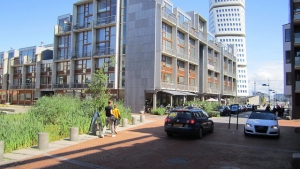

Photo by la Citta Vita is licensed under CC BY 2.0
Will drivers ever give up their automobiles? Maybe not, but thousands will limit the time spent in cars if a mixed-use development trend continues to grow.
Public officials, educators and taxpayers have all come to love mixed-use development. It solves many problems and appeals to the masses in a myriad of ways. In fact, mixed-use development has become one of the most attractive new ways to generate revenue, reduce traffic, cut down on emissions, more efficiently provide first responder protection and fund public projects.
Young professionals prefer a lifestyle based on “walkability.” Neighborhoods where markets, restaurants, entertainment, shops and offices are all located within walking distance quickly become “hot property.” Public officials benefit because of enhanced property values as well as new revenue from retail establishments. Universities have found that mixed-use development on campus property is not only a student-pleaser, but it also generates revenue that is sorely needed for university projects.
And, because public funding is inadequate or simply not available for thousands of much-needed projects, mixed-use development has become a staple to provide revenue streams that supports large public-private partnerships (P3/PPPs).
Late last year, a study commissioned by the University of Massachusetts and the town of Amherst resulted in a recommendation that mixed-use development could accomplish two primary objectives. The university needed additional student housing and the city of Amherst needed to enhance its tax base. Mixed-use development was a solution for both and a project has been launched.
A partnership that revitalized a part of Green Bay resulted in the transformation of a former canning company site into a mixed-use development. The area is now home to offices for the chamber of commerce, a brewery and pub, other office space and numerous warehouses. There is still land available for development and a mixed-use neighborhood project is now under consideration.
City leaders in Miami met recently to talk about infrastructure plans. The city wanted to reduce traffic congestion and discussions centered on how to increase walkability and encourage more bike riding. It was decided that the city’s green spaces could be used to enhance transportation options. Mixed-use development around transit hubs became an attractive option. Ridership on public transportation would be increased with new transit hubs, and revenue from retail outlets would generate funding for project costs. Mixed-use development is becoming a very common component of large public initiatives.
It’s a fast-growing trend, and definitely one to watch. Contact our experts at SPI for related government procurement opportunities.
